It’s fair to say that our levels of planning ahead have diminished somewhat since setting off. Before we left, we spent hours perusing guide books and websites, looking out for the best places to go in the first two countries. At one point, we even had our accommodation booked for the upcoming seven weeks. At the moment, we know where we’re staying for the next three days, and we’ll probably look at the guide books for our next destination while we’re on the flight. Part of it is time, as we’ve been busy trekking around national parks and looking at volcanoes rather than thinking ahead. We also want to make sure we’re enjoying where we are now. It seems wrong to be looking at the sights of a completely different country while you’re supposed to be enjoying the one you’re in.
Within this state of living in the current moment and barely peeping at what’s coming next, there have been plenty of moments where, despite our best efforts, we look around us and wonder what on earth is going on. It’s both pat of the charm and confusion of this trip. To be expected perhaps, especially in countries where we are not fluent in the language. Over the course of the last three months, there have been several times that we’ve found ourselves adrift, a puddle of confusion while the rest of the world continues around us, oblivious.

The views are too pretty to plan ahead
For me, the most recent has come around thanks to the joys of a left-hand drive car while navigating the roads in Chile. Yes, I know, the UK is hugely outnumbered in its resolution to keep to the left while driving, but when it is the only thing you’ve even known (apart from a short stint in France in a ‘normal’ car), it can leave you feeling more than a little lost.
The first confusion arises from simple movements that have become so commonplace I’m not consciously aware of them. Hence why I’ve spent the last ten days smacking my hand on the door when I’m trying to change gear, flailing around on the wrong side for a seatbelt, and using the side mirror more than the rear one because I’m looking the wrong way. Just to add to the fun, Chilean roads have offered their own unique idiosyncrasies to confuse me even further.
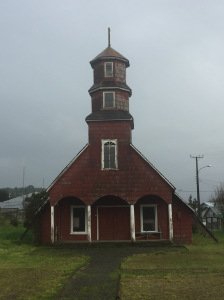
One of the Jesuit churches on the Chiloe peninsula
The speed limit is either something all locals mostly ignore, or there is a secret way of signalling how fast to go that we were not aware of. Occasionally, there were signs. As you would expect, a red lollipop showing you whether it was 50, 60 70 or 120 (yes, in km, which made no sense to me). But then there was nothing. The road would open out, or the roadworks would end, and there was no indication of how fast we should go. So were we supposed to keep the the same speed? The trucks and cars thundering past us suggested otherwise, unless there is generally a cavalier approach to using your accelerator. In the end, we tried to go for an average based on those around us, which seemed to work ok.
Perhaps more concerning was the lack of signs to indicate a one-way road. It was hard enough to remember to keep the car on the right side, but when cars started driving to the left of me I had no idea what was going on. Once we’d been waved at furiously by a passing pedestrian who clearly thought us driving up a particular road was a bad idea, we noticed an addition to the road names. Underneath them was an arrow, either one way or both, so we avoided any accidents after noticing this particular feature. Other driving habits included going into the hard shoulder when someone is overtaking you, and flashing the person in front of you before you overtake them. The first time this happened I started panicking – was there a problem with my lights? Was the boot open? Turns out it’s just something they do. So much for a relaxing drive around the Lake District of Chile.
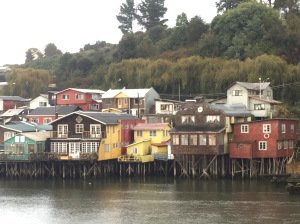
The lovely Palafitos in Castro. But what time is it?
Perhaps our most confusing day in Chile was about a week after we arrived. Having successfully caught up with the time difference from a shocking fifteen-hour shift, we were fairly confident we knew what time it was. In the middle of the night, the baby woke up. I checked the time. 4am. Rather early for her, ad she wouldn’t seem to settle without feeding. I didn’t think anything else of it and we woke up and carried on with our day. We were driving down to get the ferry to Chiloe – a peninsula not far from Puerto Montt which houses a unique culture and some unusual Jesuit churches that arose from some very keen attempts at conversion. A portion of land with its own flora and fauna, decorated with wooden houses on stilts and bright painted churches. We were also hoping to catch a glimpse of some otters and penguins along the way.
It was a grey day, and the road led straight onto the ferry, rather than waiting for tickets or boarding. We drove on, and the boat started chugging beneath us. Our bellies were feeling empty, so we were munching on empanadas (again) that we’d bought from a supermarket just before the ferry. Around us, no-one seemed to be eating. In fact, it felt as though people were looking at us strangely. It was then we realised that the car clock was showing a different time to our phones. In my broken Spanish, I asked the man who sold the tickets if the time was different. He looked at me like I was from another planet. Yes, he said, the clocks had gone back an hour. Of course, we’d forgotten that for the Chileans it is pretty much November, and the winter days are starting to settle in. Without realising, we’d spent the whole morning operating an hour out of synch with the rest of the country. So much for blending in with local culture.

Where’s the party?
There have been other times when we’ve been bemused about our surroundings. Just the other week in Valparaiso, we woke to thumping music, someone shouting into a microphone, accompanied by shouting and cheering. It was only eight in the morning. Resolving to follow the noise once we were up and about, we got on with the business of breakfast and preparing for the day. By the time we left out apartment and ventured into the streets, the noise had stopped. There was nothing to explain the huge commotion of earlier. The next day, exactly the same thing happened. No throngs in the street, no huge sound systems. Just people going about their day. We still don’t know why there was an early morning party that we weren’t invited to.
In Australia, we had the opposite experience. Since our arrival, people had been warning us of how busy it would be over Easter weekend. We had resolved to book a campsite far in advance, but somehow we hadn’t got round to it. Good Friday was the following day and we had nothing booked. The roads will be swamped, we were warned. It can take hours to travel just a few miles. Steeling ourselves for the worst, we decided that if it came to it, we could just get as far as we could and stop if she needed feeding or it was getting too much to wait in traffic.
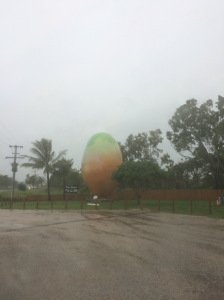
A giant mango. No-one knows why.
The following morning, we set off early. We were hoping to cover around three hours of driving, with a stop at the Bundaberg distillery on the way. Pulling out onto the highway, there were only a few cars. So far, so good. The weather was a little gloomy, with possible breaks in the cloud ahead. There were snacks and water in the front of the van and we had provided the little one with plenty of toys to keep her amused.
After an hour, if anything, the roads had got quieter. We pulled off the main road into Bundaberg. The Australian towns we saw made me think of the wild west. The shops had a facade over the top of them, scalloped in the way I associate with the bars you get in Western films. They also seem to be low, with lines of shops down either side of the street rather than high rises. In the same way, this had me thinking more of showdowns at high noon than surf shacks and barbecues (oh how stereotypical my geographical ideas are). This particular morning, a tumbleweed would not have been out of place. There were no cars apart from our rumbling wheels. There were no people walking along. There weren’t even any figures to be seen moving around inside any of the shops. All of them were dark, the occasional ‘closed’ sign blinking in the gloom. Of course, a national holiday would mean things were closed, but why was everything so dead? Where were the thronging cars we had been told to expect?

Ok, this is an old photo, but you see what I mean.
As we got closer to the distillery, we began to doubt the truth of the website, which claimed it would be open. Marked by a giant bottle of rum (they like making big models of things. We saw a giant banana, a giant mango and a huge bottle of beer), we followed the signs to our eerily quiet destination. Parked in the incredibly empty car park was another camper van, its inhabitants milling around outside. Clearly they had not got the message either. Needless to say, we did not get our rum tour, nor our free sample, and had to get back on the road empty handed.
This state of affairs continued. It felt like we were driving through the world after a zombie apocalypse. We were beginning to despair that we’d find anything open at all, as we didn’t have enough food for dinner that night. Perhaps there had been an enormous party the night before that everyone was recovering from, skulking around their houses and waiting for hangovers to clear. Or perhaps, even worse, there was an enormous party happening at that very moment. I felt enormously left out. Somewhere, huge groups of people were having an inordinate amount of fun while we were simply covering miles on empty roads. It was probably a huge cultural experience that we were missing out on.
We arrived at our intended campsite and found that there were spaces, and there were events happening over the weekend. We stood under a canopy and watched fire performers and listened to live music, eating Chinese food from the onsite van and drinking beer from our fridge. At least we didn’t miss out completely.
The same thing happened in New Zealand, when we arrived in Picton to get the ferry to the north island, and realised that it was ANZAC day. Once again, there was the sense of an opportunity missed. Surely there were celebrations, opportunities to talk to the locals and really get involved in the place we were staying. Alas, this was not to be our fate. Instead we got onto a very quiet ferry and got wonderfully lost while trying to find a campsite in Wellington. Not exactly the kind of excitement I was thinking of.
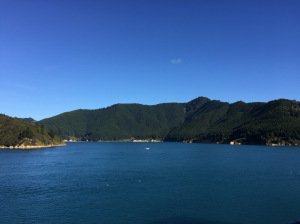
Our ferry crossing was unusually quiet
My final confusion has revolved around seasons and climates. As someone who has spent most of their life in the UK, I’m accustomed to experiencing a range of seasons in one day. It’s not uncommon to leave the house with an umbrella, a jumper and a vest top under your T-shirt, just to cover all eventualities. But at least I know (roughly) when to expect certain temperatures and sights. In Japan, we went from winter to winter, with the same chilly temperatures and occasional snow making me feel more secure with when it was in the year, even if the surroundings were so strange. Just as we left, the pink tinges in the trees told of the spring that was just about to arrive.
Then in Singapore, we jumped to a very early summer. The temperature never dropped below 27, and we were treated to tropical rains in between. Just a week later and we were in Australia, which started off with what felt like an extended summer. While it might seem chilly to Aussies, we were enjoying the kind of temperatures you’d be pleased with in August back home. But then it rained for three weeks and the trees started to turn, catapulting us forward into autumn.
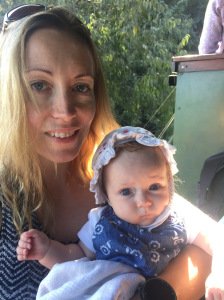
It’s summer! No, spring! No, autumn!
In New Zealand, our autumn continued in a blaze of colour with occasional snow, and chilly temperatures. Dropping down in Chile placed us back in what felt like late spring, with the warmth of the sun enough to warrant a T-shirt, although the leaves persisted in dropping and crisping beneath our feet. What on earth had happened to spring? A short flight to the south of the country plunged us back into chillier temperatures which at least sat better with the changing seasons.
In a few days we will be back to the equator in Costa Rica, with the heat staying stable and abundant storms. No wonder packing was so difficult. It seems that my skin has just adjusted to the warmth of the sun before it is thrust back under layers to be protected from rain or a cold wind. I’m also very sad to have only caught a glimpse of spring, when I usually love to see the impossibly bright green of new leaves and the flurry of flowers that indicates an end to gloomy evenings.
As for time difference, it says something that we are quite pleased that the biggest time difference that we have to worry about between now and when we get home is five hours, which seems a piffling amount compared to the nine or, even worse, fifteen hour lurches through time that we have experienced so far.
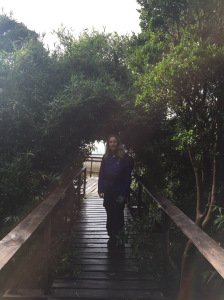
Knowing what’s going on is overrated
Part of me loves this confusion. How to drive, what is happening, what season it is, what people are saying, and what on earth the food is that I’m just about to eat. All of it makes each day a challenge. In daily life, it’s not often that you feel completely adrift from a sense of time and place, or that you feel like a complete foreigner in your surroundings. It’s also unnerving, as I think a part of us all craves a sense of belonging and predictability to ground us.
But there will be time for the expected, and for waking up and knowing the intricacies of each day. For now, I will wallow in my confusion, enjoying the flutter of disorientation and storing it away for the times I feel that life is too boring. Until then, it is anything but.
#travelblogger #travel #travelling #baby #adventure #travelblog

0 Comments